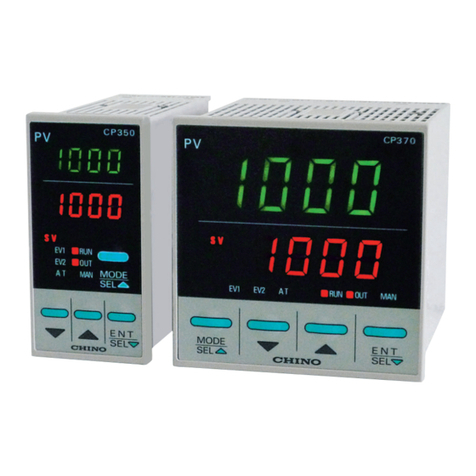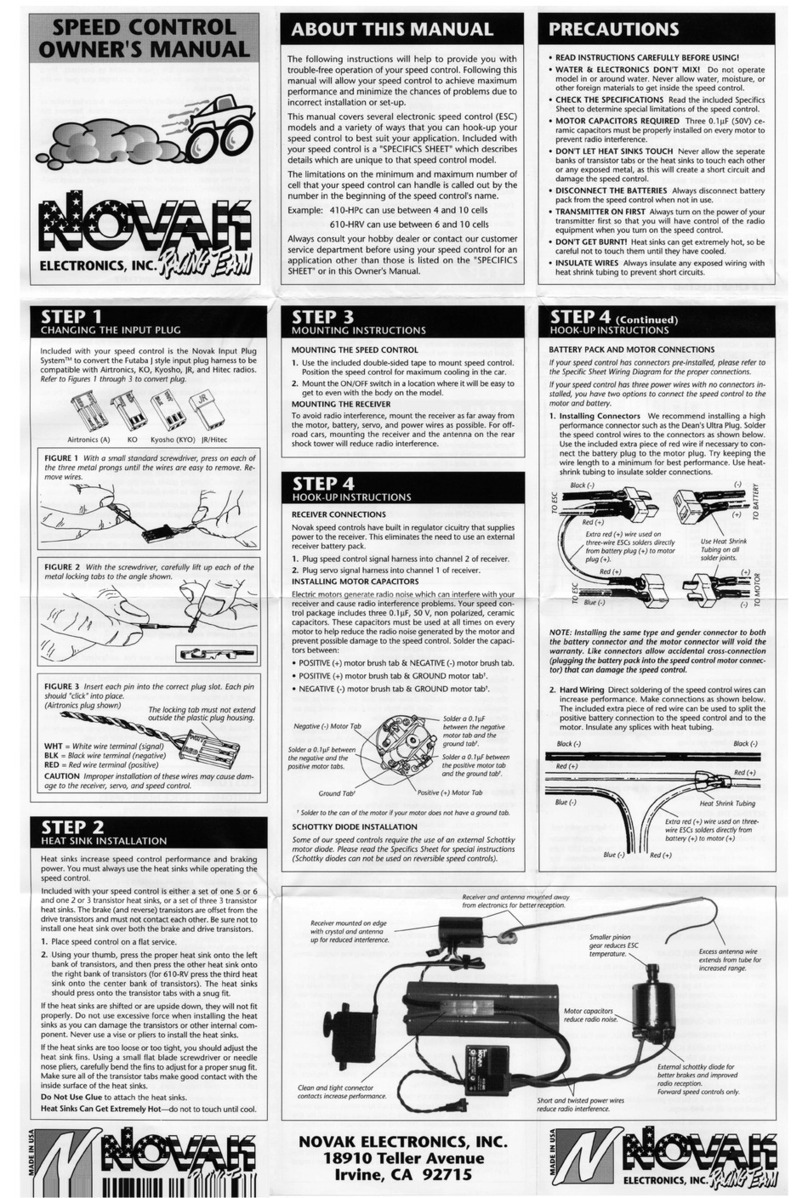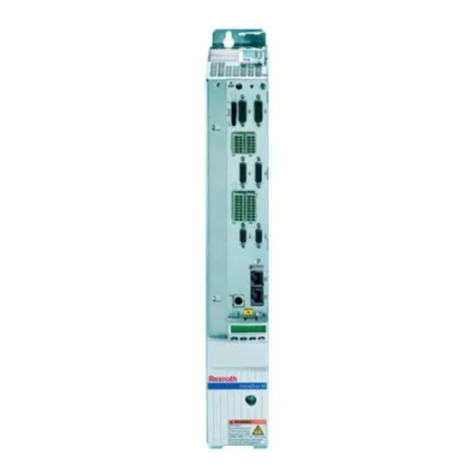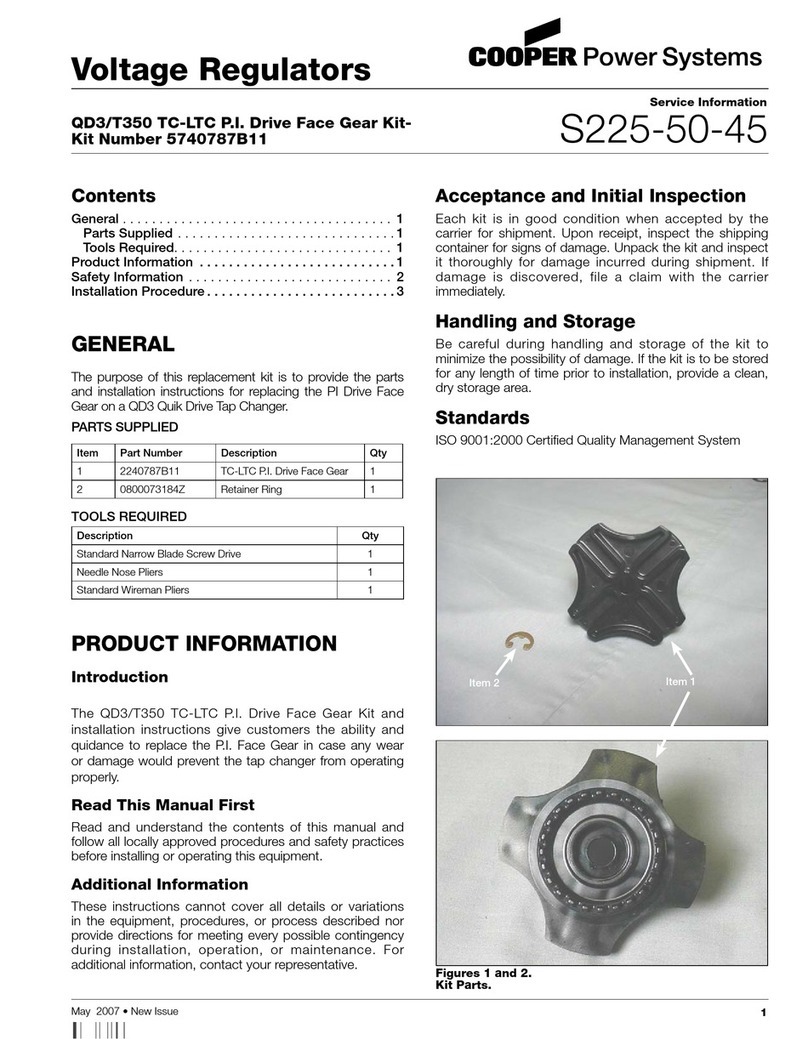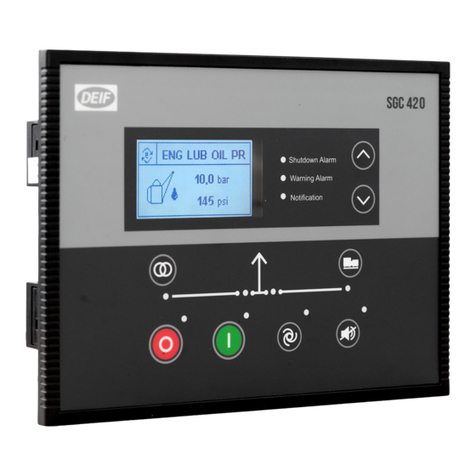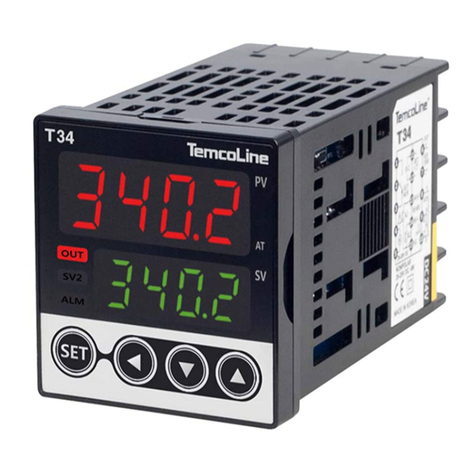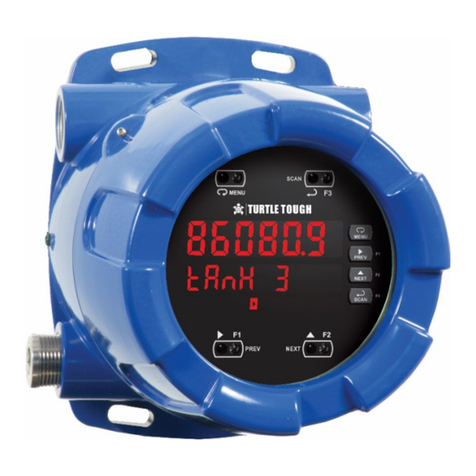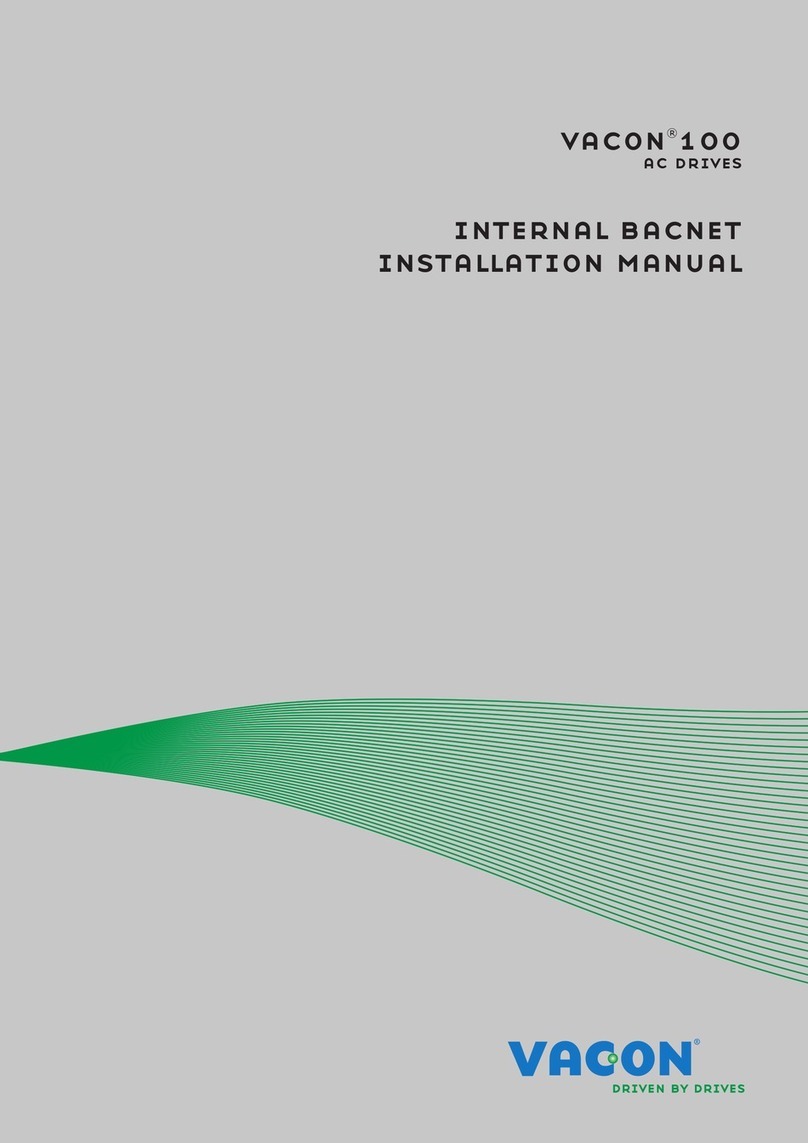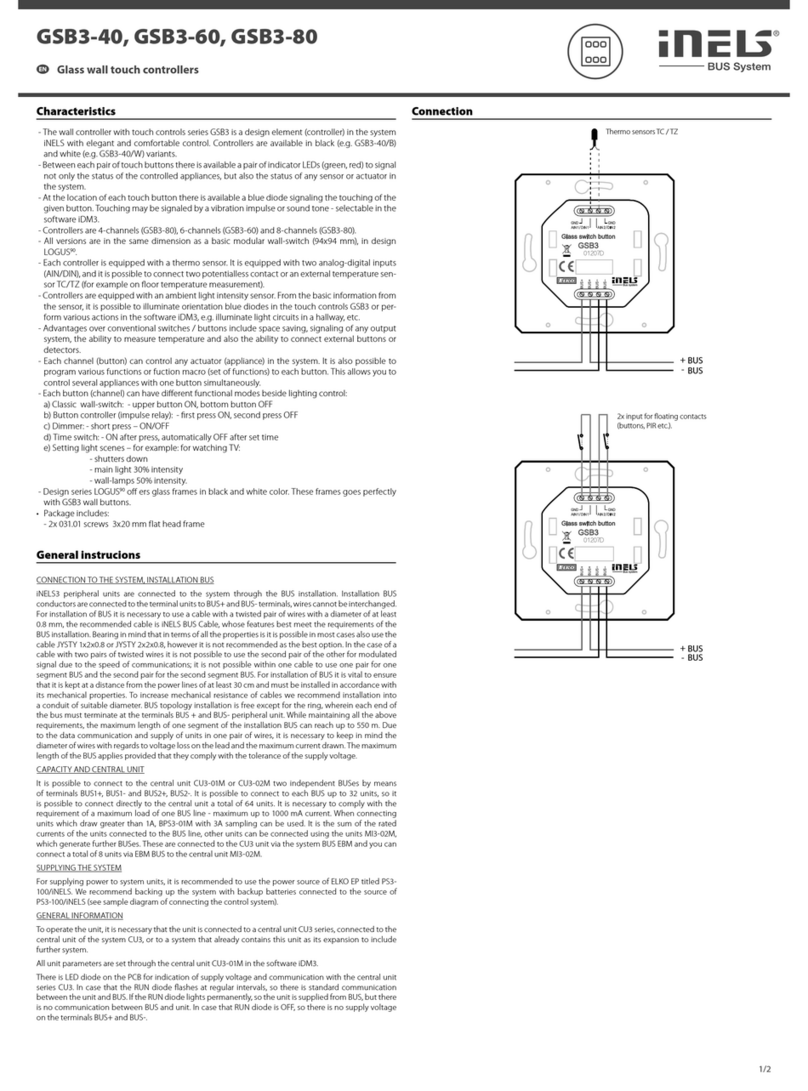TechLine LA35 User manual

USER MANUAL
ACTUATOR
LA35
To learn more about LINAK, please visit:
www.linak.com

Page 2 of 40

Page 3 of 40
Contents
Preface .........................................................................................................................................................................5
LINAK application policy................................................................................................................................................6
Chapter 1
Safety instructions..................................................................................................................................................... 7-8
Chapter 2
Mounting guidelines................................................................................................................................................ 9-10
Mounting of cables .....................................................................................................................................................11
Electrical installation:...................................................................................................................................................12
Recommended fuse...........................................................................................................................................12
Actuator without feedback................................................................................................................................13
Actuator with:
Potential free endstop signal output........................................................................................................14
Relative positioning - Single Hall....................................................................................................... 15-16
Potential free endstop signals and relative positioning - Single Hall.................................................... 17-18
Absolute positioning - Analogue feedback......................................................................................... 19-20
Potential free endstop signals and absolute positioning - Analogue feedback..................................... 21-22
IC..................................................................................................................................................... 23-25
Chapter 3
Troubleshooting .................................................................................................................................................... 26-27

Page 4 of 40
Contents
Chapter 4
Specifications..............................................................................................................................................................28
Usage .........................................................................................................................................................................28
Actuator dimensions....................................................................................................................................................29
Speed and current curves:...................................................................................................................................... 30-31
12V motor...........................................................................................................................................................30
24V motor...........................................................................................................................................................31
Label for LA35 ............................................................................................................................................................32
Key to symbols ............................................................................................................................................................33
LA35 Ordering example...............................................................................................................................................34
Chapter 5
Maintenance...............................................................................................................................................................35
Repair.........................................................................................................................................................................35
Main groups of disposal ..............................................................................................................................................35
Warranty ....................................................................................................................................................................36
Declaration of conformity ............................................................................................................................................37
Declaration of incorporation of partly completed machinery..........................................................................................38
Adresses .....................................................................................................................................................................40

Page 5 of 40
Preface
Dear User,
We are delighted that you have chosen a product from LINAK®.
LINAK systems are high-tech products based on many years of experience in the manufacture and development
of actuators, electric control boxes, controls, and chargers.
This user manual does not address the end-user, but is intended as a source of information for the manufacturer
of the equipment or system only, and it will tell you how to install, use and maintain your LINAK electronics. It
is the responsibility of the manufacturer of the end-use product to provide a User Manual where relevant safety
information from this manual is passed on to the end-user.
We are sure that your LINAK product/system will give you many years of problem-free operation. Before our
products leave the factory they undergo full function and quality testing. Should you nevertheless experience
problems with your LINAK product/system, you are always welcome to contact your local dealer. LINAK
subsidiaries and some distributors situated all over the world have authorised service centres, which are always
ready to help you.
LINAK provides a warranty on all its products. This warranty, however, is subject to correct use in accordance with
the specifications, maintenance being done correctly and any repairs being carried out at a service centre, which
is authorised to repair LINAK products.
Changes in installation and use of LINAK products/systems can affect their operation and durability. The products
are not to be opened by unauthorised personnel.
The User Manual has been written based on our present technical knowledge. We are constantly working on
updating the information and we therefore reserve the right to carry out technical modifications.
LINAK A/S

Page 6 of 40
The purpose of the application policy is to define areas of responsibilities in relation to applying a LINAK product
defined as hardware, software, technical advice, etc. related to an existing or a new customer application.
LINAK products as defined above are applicable for a wide range of applications within Medical, Furniture, Desk,
and Industry areas. Yet, LINAK cannot know all the conditions under which LINAK products will be installed, used,
and operated, as each individual application is unique.
The suitability and functionality of the LINAK product and its performance under varying conditions (application,
vibration, load, humidity, temperature, frequency, etc.) can only be verified by testing, and shall ultimately be the
responsibility of the LINAK customer using any LINAK product.
LINAK shall be responsible solely that LINAK products comply with the specifications set out by LINAK and it
shall be the responsibility of the LINAK customer to ensure that the specific LINAK product can be used for the
application in question.
LINAK application policy

Page 7 of 40
Chapter 1
Safety instructions
Please read this safety information carefully:
Be aware of the following three symbols throughout the user manual:
Warning!
Failing to follow these instructions can cause accidents resulting in serious personal injury.
Recommendations
Failing to follow these instructions can result in the actuator suffering damage or being ruined.
Additional information
Usage tips or additional information that is important in connection with the use of the actuator.
Furthermore, ensure that all staff who are to connect, mount, or use the actuator are in possession of the necessary
information and that they have access to this user manual.
Persons who do not have the necessary experience or knowledge of the product/products must not use the
product/products. Besides, persons with reduced physical or mental abilities must not use the product/products,
unless they are under surveillance or they have been thoroughly instructed in the use of the apparatus by a person
who is responsible for the safety of these persons.
Moreover, children must be under surveillance to ensure that they do not play with the product.
Before you start mounting/dismounting, ensure that the following points are observed:
• The actuator is not in operation.
• The actuator is free from loads that could be released during this work.
Before you put the actuator into operation, check the following:
• The actuator is correctly mounted as indicated in the relevant user instructions.
• The equipment can be freely moved over the actuator’s whole working area.
• The actuator is connected to a mains electricity supply/transformer with the correct voltage and which is
dimensioned and adapted to the actuator in question.
• Ensure that the voltage applied matches to the voltage specified on the actuator label.
• Ensure that the connection bolts can withstand the wear.
• Ensure that the connection bolts are secured safely.

Page 8 of 40
During operation, please be aware of the following:
• Listen for unusual sounds and watch out for uneven running. Stop the actuator immediately if anything
unusual is observed.
• Do not sideload the actuator.
• Only use the actuator within the specified working limits.
• Do not step or kick on the actuator.
When the equipment is not in use:
• Switch off the mains supply in order to prevent unintentional operation.
• Check regularly for extraordinary wear.
Classification
The equipment is not suitable for use in the presence of a flammable anaesthetic mixture with air or with oxygen
or nitrous oxide.
Warnings
• Do not sideload the actuator.
• When mounting the LA35 in the application ensure that the bolts can withstand the wear and that they are
secured safely.
• If irregularities are observed, the actuator must be replaced.
Recommendations
• Do not place load on the actuator housing and do prevent impact or blows, or any other form of stress to
the housing.
• Ensure that the cable cover is mounted correctly. Use 3.5Nm torque.
• Ensure that the duty cycle and the usage temperatures for LA35 actuators are respected.
• Ensure that the cable cannot be squeezed, pulled or subjected to any other stress.
• Furthermore, it will be good practice to ensure that the actuator is fully retracted in the “normal” position.
The reason is that there will be a vacuum inside the actuator if it is extended which over time can lead to
water entering the actuator.
• If the actuator (without integrated controller) is mounted in an application where a mechanical stop prevents
the endstop switches in the actuator from being activated, the actuator must be equipped with an electrical
safety device (current monitoring) or external limit switch.

Page 9 of 40
X
X
Mounting guidelines
LINAK®linear actuators are quickly and easily mounted by slipping pins through the holes on each end of the units
and into brackets on the machine frame and the load.
Figure 2
WrongWrong Wrong
Chapter 2
Figure 1
The mounting pins must be parallel to each other as
shown in Figure 1. Pins, which are not parallel to each
other, may cause the actuator to bend and be damaged.
The load should act along the stroke axis of the actuator
as off-centre loads may cause bending and lead to
premature failure. See Figure 2.
Make sure the mounting pins are supported in both ends.
Failure to do so could shorten the life of the actuator.
Also, avoid applying a skew load on the actuator.
The actuator can rotate around the pivot point in the front and rear end. If this is the case it is of high importance
that the actuator is able to move freely over the full stroke length, both during the development and daily operation.
Please pay special attention to the area around the housing where parts can be trapped and cause damage to the
application and actuator.
In applications with high dynamic forces LINAK recommends not to use the fully extended or retracted position
over longer time, as this can damage the endstop system permanently.
Right
Please be aware that if the LA35 is used for solar applications the actuator must be mounted with the
motor housing turned upwards and the wires pointing downwards.

Page 10 of 40
Mounting guidelines
030618/DS
Instruktion vedr. uddrejning af inderrør – LA27 + LA27C
Til salesbackup, brugsanvisning og datablad.
Ved montage og ibrugtagning, er det ikke tilladt at dreje unødvendigt mange gange på
stempelstangsrøret. Hvis øjet ikke er positioneret korrekt, er det tilladt først at skrue
røret i bund (1), og derefter skrue det maksimalt ½ omgang ud igen (2).
• The mounting pins must have the correct dimension.
• The bolts and nuts must be made of a high quality steel grade (e.g. 10.8).
No thread on the bolt inside the back fixture or the piston rod eye.
• Bolts and nuts must be protected so there is no risk for them to fall out.
• Do not use a torque that is too high when mounting the bolts for the back fixture or the piston rod
eye. This will stress the fixtures.
Please note:
The piston rod eye is only allowed to turn 0-90 degrees.
Instruction concerning the turning of the piston rod eye and inner tube:
• When mounting and taking into use, it is not permitted to make excessive turns of the piston rod
eye. In cases where the eye is not positioned correctly, it is permitted to first screw the eye down
to its bottom position, at a maximum torque of 2Nm (1), and thereafter a maximum 90 degrees
turn outwards again (2).
• As the piston rod eye can turn freely, it is important to ensure that the eye cannot rotate if the
actuator is used in a pull application. If this happens, the actuator will be pulled apart and destroyed.
Warning!
If the actuator is used for pull in an application where personal injury can occur, the
following is valid:
It is the application manufacturer’s responsibility to incorporate a suitable safety arrangement, which
will prevent personal injury from occurring, if the actuator should fail.
Warning!
LINAK’s actuators are not designed for use within the following fields:
• Offshore installations • Explosive environments
• Aeroplanes and other aircraft • Nuclear power generation

Page 11 of 40
Mounting of cables
When changing the cables on a LINAK actuator, it is important that this is done carefully, in order to
protect the plugs and pins. Before the new cable is mounted, we recommend that the socket is greased
with vaseline, to keep the high IP protection and ensure an easy mounting. Please be sure that the plug is
in the right location and fully pressed in before the cable lid is mounted.
Please note that if the cables are mounted and dismounted more than 3 times the plugs can be damaged.
Therefore, we recommend that such cables are discarded and replaced.
Also note that the cables should not be used for carrying the actuator.
We recommend to take some precaution and design the wire connection in a way, where the cable end is
kept inside a closed, protected area to guarantee the high IP protection.
3. Slide the cover onto
the actuator.
The torque of the
cover screw is
approx. 3.5 ± 0.2 Nm
TORX 25IP
1. Unscrew the cover and remove the two
cables and/or blind plugs.
2. Plug in the power cable and/or
the signal cable.

Page 12 of 40
Electrical installation
• To ensure maximum self-locking ability, please be sure that the motor is shorted when stopped.
Actuators with integrated controller provide this feature, as long as the actuator is powered.
• When using soft stop on a DC-motor, a short peak of higher voltage will be sent back towards the
power supply. It is important when selecting the power supply that it does not turn off the output,
when this backwards load dump occurs.
The power supply for actuators without integrated controller must be monitored externally and cut off
in case of current overload.
Recommended fuse for actuators without integrated controller
Type Spindle Pitch
(mm)
Thrust max.
Push/Pull
(N)
Typical Amp.
at full load
(A)
24V 12V
Recommended
fuse
24V 12V
3510xx... 3 6000 / 4000 4.2 7.5 8.4 15.0
3520xx... 5 4000 4.8 7.7 9.6 15.4
3521xx... push brake 5 4000 4.3 7.8 8.6 15.6
3522xx... pull brake 5 4000 4.6 8.4 9.2 16.8
3530xx... 9 1500 2.6 5.9 5.2 11.8
3531xx... push brake 9 1500 2.9 5.5 5.8 11.0
3532xx... pull brake 9 1500 3.0 5.4 6.0 10.8
3540xx... 12 1000 2.8 5.3 5.6 10.6
3541xx... push brake 12 1000 2.8 5.5 5.6 11.0
3542xx... pull brake 12 1000 2.9 5.6 5.8 11.2

Page 13 of 40
Actuator without feedback
BROWN
BLUE
Connection diagram:
Fig. 1 : 35xxxxx00xxxxxx
Input/Output Specification Comments
Description Permanent magnetic DC motor.
See connection diagram,
fig. 1 above
Brown 12 or 24VDC (+/-)
12V ± 20%
24V ± 10%
Under normal conditions:
12V, max. 10A depending on load
24V, max. 5A depending on load
To extend actuator:
Connect Brown to positive
To retract actuator:
Connect Brown to negative
Blue To extend actuator:
Connect Blue to negative
To retract actuator:
Connect Blue to positive
Red Not to be connected
Black Not to be connected
Green Not to be connected
Yellow Not to be connected
Violet Not to be connected
White Not to be connected
I/O specifications:

Page 14 of 40
Actuator with potential free endstop signal output
Connection diagram:
Fig. 2 : 35xxxxx10xxxxxx
I/O specifications:
YELLOW
GREEN
BROWN
BLUE
RED
+
IN
OUT
Input/Output Specification Comments
Description
The actuator is equipped with poten-
tial free endstop signals out. The micro
switches are normally open.
See connection diagram,
fig. 2 above
Brown 12 or 24VDC (+/-)
12V ± 20%
24V ± 10%
Under normal conditions:
12V, max. 10A depending on load
24V, max. 5A depending on load
To extend actuator:
Connect Brown to positive
To retract actuator:
Connect Brown to negative
Blue To extend actuator:
Connect Blue to negative
To retract actuator:
Connect Blue to positive
Red
Potential free signal power supply (+)
10-28VDC
Switching capacity:
Minimum 10mA
Maximum 1A
Black Not to be connected
Green
Endstop signal out Output voltage is the same as the
input voltage
Yellow
Endstop signal in
Violet Not to be connected
White Not to be connected
IN
OUT

Page 15 of 40
Actuator with relative positioning - Single Hall
Connection diagram:
Fig. 3 : 35xxxxx0Hxxxxxx
BROWN
BLUE
WHITE
VIOLET
BLACK
+
-

Page 16 of 40
Actuator with relative positioning - Single Hall
I/O specifications:
Input/Output Specification Comments
Description The actuator is equipped with Single Hall
that gives a relative positioning feedback
signal when the actuator moves.
See connection diagram,
fig. 3, page 15
Brown
12-24VDC (+/-)
12V ± 20%
24V ± 10%
Under normal conditions:
12V, max. 10A depending on load
24V, max. 5A depending on load
To extend actuator:
Connect Brown to positive
To retract actuator:
Connect Brown to negative
Blue To extend actuator:
Connect Blue to negative
To retract actuator:
Connect Blue to positive
White Signal power supply (+)
10-28VDC
Current consumption:
Max. 40mA, also when the actuator
is not running
Black Signal power supply GND (-)
Green Not to be connected
Yellow Not to be connected
Violet Single Hall output (PNP)
Movement per single Hall pulse:
3mm pitch = 0.38mm per pulse
5mm pitch = 0.63mm per pulse
9mm pitch = 1.13mm per pulse
12mm pitch = 1.5mm per pulse
Frequency:
Frequency is 30-125 Hz on Single Hall
output depending on load.
Every pulse is “ON” for minimum 3ms.
Overvoltage on the motor can result in
shorter pulses.
Output voltage min. VIN - 2V
Max. current output: 12mA
Max. 680nF
N.B. For more precise measurements,
please contact
LINAK A/S.
Low frequency with a high load.
Higher frequency with no load.
Diagram of Single Hall:
Red Not to be connected
Fig. 3.1
Micro -
Processor
Input Single Hall output
Hall B
Hall A

Page 17 of 40
Actuator with potential free endstop signals and relative positioning -
Single Hall
Connection diagram:
Fig. 4 : 35xxxxx1Hxxxxxx
BROWN
BLUE
YELLOW
GREEN
RED
VIOLET
BLACK
+
-
IN
OUT
WHITE
+

Page 18 of 40
Actuator with potential free endstop signals and relative positioning -
Single Hall
I/O specifications:
Input/Output Specification Comments
Description The actuator is equipped with potential
free endstop signals and Single Hall that
gives a relative positioning feedback signal
when the actuator moves.
See connection diagram,
fig. 4, page 17
Brown
12-24VDC (+/-)
12V ± 20%
24V ± 10%
Under normal conditions:
12V, max. 10A depending on load
24V, max. 5A depending on load
To extend actuator:
Connect Brown to positive
To retract actuator:
Connect Brown to negative
Blue To extend actuator:
Connect Blue to negative
To retract actuator:
Connect Blue to positive
White Signal power supply (+)
10-28VDC
Current consumption:
Max. 40mA, also when the actuator is
not running
Black Signal power supply GND (-)
Green Endstop signal out Output voltage min. VIN - 2V
Source current max. 100mA
NOT potential free
Yellow Endstop signal in
Violet Single Hall output (PNP)
Movement per Single Hall pulse:
3mm pitch = 0.38mm per pulse
5mm pitch = 0.63mm per pulse
9mm pitch = 1.13mm per pulse
12mm pitch = 1.5mm per pulse
Frequency:
Frequency is 30-125 Hz on Single Hall
output depending on load and spindle.
Overvoltage on the motor can result in
shorter pulses.
Output voltage min. VIN - 2V
Max. current output: 12mA
Max. 680nF
N.B. For more precise measurements,
please contact
LINAK A/S.
Low frequency with a high load.
Higher frequency with no load.
Red Potential free signal power supply (+)
10-28VDC
Switching capacity:
Minimum 10mA
Maximum 1A

Page 19 of 40
Actuator with absolute positioning - Analogue feedback
Connection diagram:
Fig. 5 : 35xxxxx0xxxxxxx
BROWN
BLUE
WHITE
VIOLET
+
BLACK
-

Page 20 of 40
Actuator with absolute positioning - Analogue feedback
I/O specifications:
Input/Output Specification Comments
Description The actuator is equipped with electronic
circuit that gives an analogue feedback
signal when the actuator moves.
See connection diagram,
fig. 5, page 19
Brown
12-24VDC (+/-)
12V ± 20%
24V ± 10%
Under normal conditions:
12V, max. 10A depending on load
24V, max. 5A depending on load
To extend actuator:
Connect Brown to positive
To retract actuator:
Connect Brown to negative
Blue To extend actuator:
Connect Blue to negative
To retract actuator:
Connect Blue to positive
White Signal power supply (+)
10-28VDC
Current consumption:
Max. 40mA, also when the actuator
is not running
Black Signal power supply GND (-)
Green Not to be connected
Yellow Not to be connected
Violet Analogue feedback
0-10V (Option A)
0.5-4.5V (Option B)
Tolerances +/- 0.5V
Max. current output: 1mA
Ripple max. 200mV
Transaction delay 100ms
Linear feedback 0.5%
It is recommendable to have the
actuator to activate its limit switches
on a regular basis, to ensure more
precise positioning
Red Not to be connected
Table of contents
Popular Controllers manuals by other brands
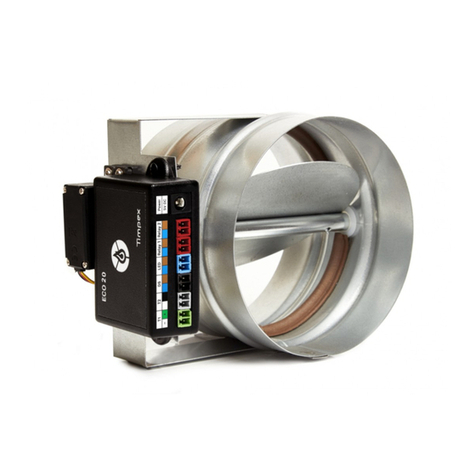
Timpex
Timpex ECO 20 user manual
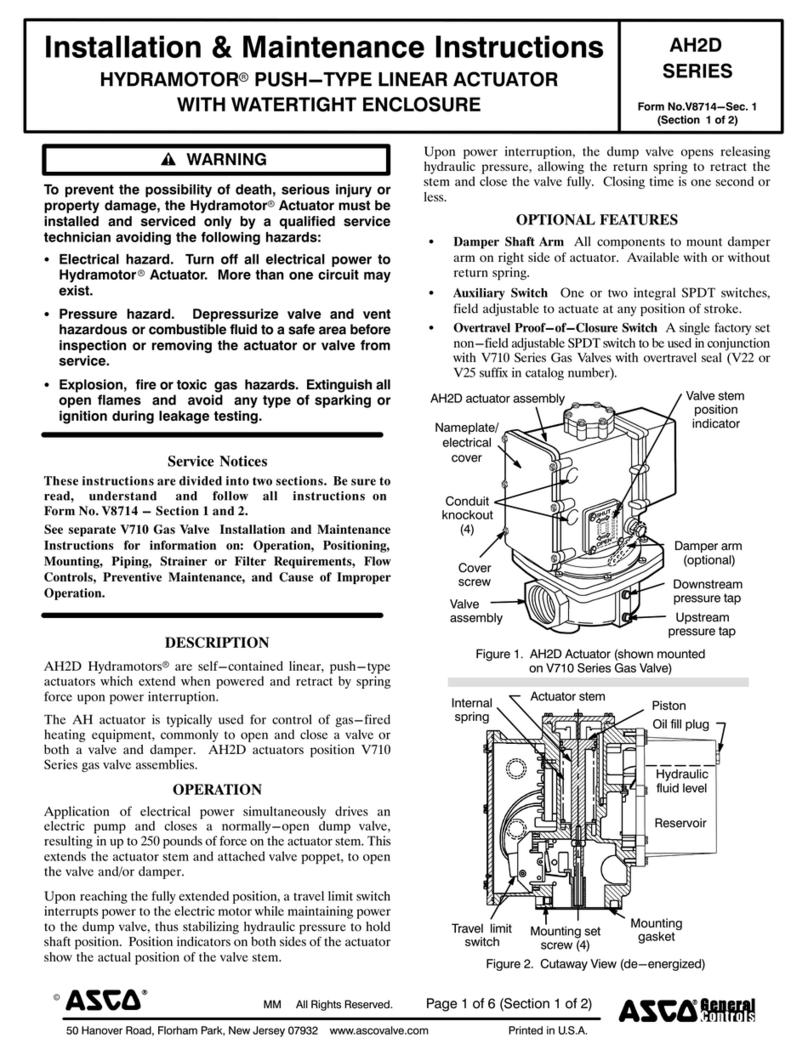
Asco
Asco Hydramotor AH2D Series Installation and maintenance instructions
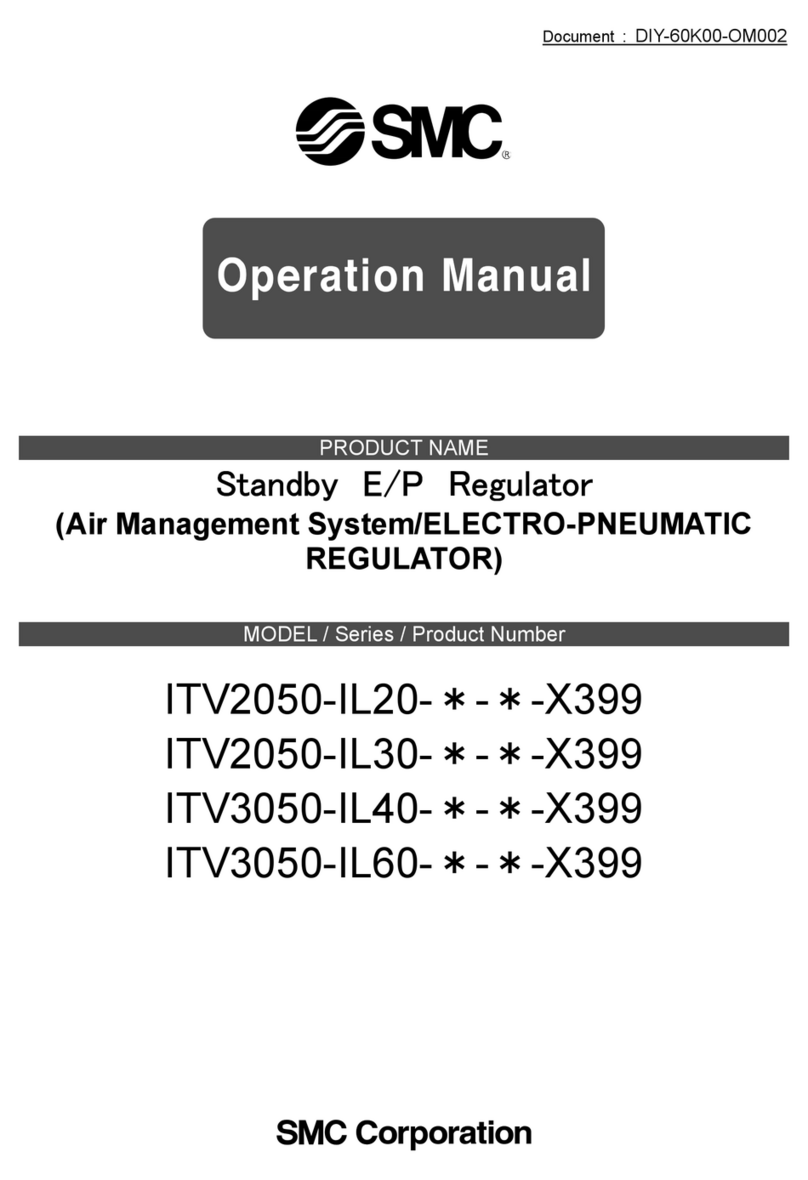
SMC Networks
SMC Networks ITV2050-IL20-X399 Series Operation manual
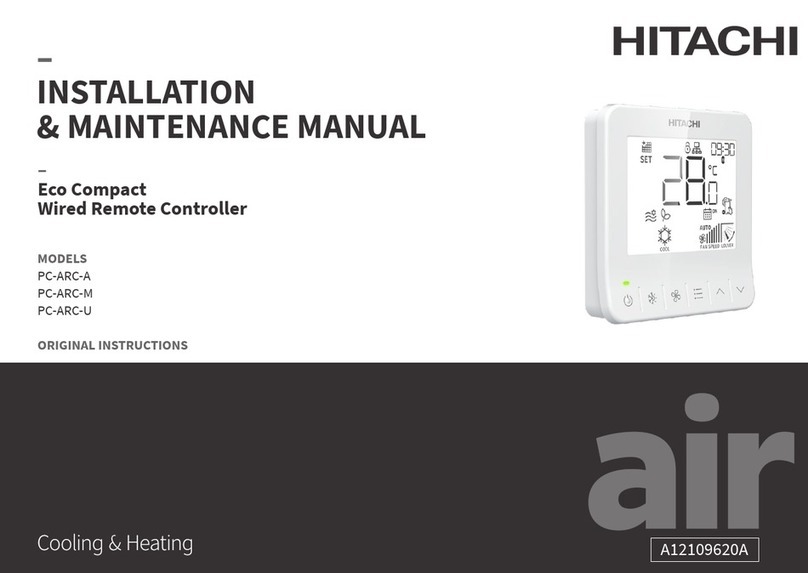
Hitachi
Hitachi Eco Compact PC-ARC-A Installation & maintenance manual
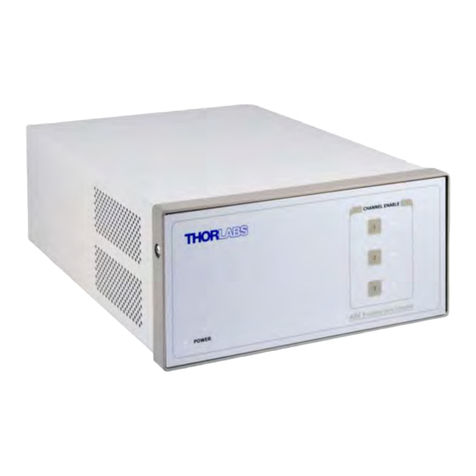
THORLABS
THORLABS BBD202 user guide
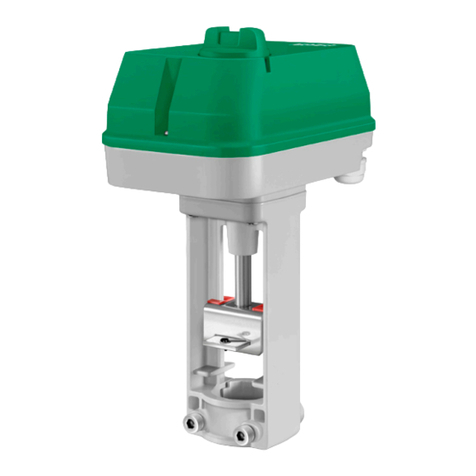
Regin
Regin RVAN25-24A Instruction
